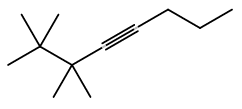
How many double bond equivalents (degrees of unsaturation) are in 2,2,3,3-tetramethyl-4-octyne?
Answer
404.7k+ views
Hint: The degree of unsaturation is a computation that calculates the total number of rings and
Complete answer:
An alkyne is an unsaturated hydrocarbon with at least one carbon—carbon triple bond in organic chemistry. With only one triple bond and no additional functional groups, the simplest acyclic alkynes form a homologous series with the generic chemical formula
The standard formula for computing the double bond equivalent (DBE) is:
where C denotes the number of carbon atoms, H denotes the amount of hydrogen and halogen atoms, and N denotes the number of nitrogen atoms in the molecule if any exist.
The molecular formula of 2,2,3,3-tetramethyl-4-octyne can be given as

There dbe equals
NMR, mass spectrometry, and IR spectroscopy, as well as qualitative examination, are used to verify the final structure. It works by comparing the current molecular formula to what may be a potential formula if the structure was saturated (no rings and just bonds) and all atoms had their normal valence.
Note:
Because joining two elements to form a ring or adding one extra bond in a structure reduces the need for two H's, the DBE (or IHD) for hydrocarbons tells us the number of rings and/or extra bonds in a non-saturated structure, which equals the number of hydrogen pairs required to make the structure saturated. For non-hydrocarbons, the elements in a pair can be any elements from the periodic table's lithium and fluorine families, although not necessarily all H's.
Complete answer:
An alkyne is an unsaturated hydrocarbon with at least one carbon—carbon triple bond in organic chemistry. With only one triple bond and no additional functional groups, the simplest acyclic alkynes form a homologous series with the generic chemical formula
The standard formula for computing the double bond equivalent (DBE) is:
where C denotes the number of carbon atoms, H denotes the amount of hydrogen and halogen atoms, and N denotes the number of nitrogen atoms in the molecule if any exist.
The molecular formula of 2,2,3,3-tetramethyl-4-octyne can be given as

There dbe equals
NMR, mass spectrometry, and IR spectroscopy, as well as qualitative examination, are used to verify the final structure. It works by comparing the current molecular formula to what may be a potential formula if the structure was saturated (no rings and just bonds) and all atoms had their normal valence.
Note:
Because joining two elements to form a ring or adding one extra bond in a structure reduces the need for two H's, the DBE (or IHD) for hydrocarbons tells us the number of rings and/or extra bonds in a non-saturated structure, which equals the number of hydrogen pairs required to make the structure saturated. For non-hydrocarbons, the elements in a pair can be any elements from the periodic table's lithium and fluorine families, although not necessarily all H's.
Recently Updated Pages
Master Class 11 Business Studies: Engaging Questions & Answers for Success

Master Class 11 Accountancy: Engaging Questions & Answers for Success

Master Class 11 Computer Science: Engaging Questions & Answers for Success

Master Class 11 English: Engaging Questions & Answers for Success

Master Class 11 Social Science: Engaging Questions & Answers for Success

Master Class 11 Economics: Engaging Questions & Answers for Success

Trending doubts
Which one is a true fish A Jellyfish B Starfish C Dogfish class 11 biology CBSE

State and prove Bernoullis theorem class 11 physics CBSE

1 ton equals to A 100 kg B 1000 kg C 10 kg D 10000 class 11 physics CBSE

In which part of the body the blood is purified oxygenation class 11 biology CBSE

One Metric ton is equal to kg A 10000 B 1000 C 100 class 11 physics CBSE

Difference Between Prokaryotic Cells and Eukaryotic Cells




